Moana-Themed Mommy, Me, and SWE Makes a Splash With Young Girls (and Their Moms), as They Learn About Engineering
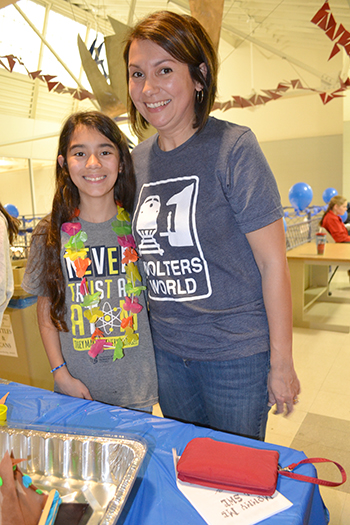
A Mommy, Me, and SWE participant and her mom.
November 14, 2017
From building a boat (then watching it sink), to building a house (then watching as it was demolished during a hurricane)—all scenarios Moana might have experienced—fourteen 4th–6th grade girls gathered at the John Deere Pavilion on Saturday, November 4, to participate in Mommy, Me, and SWE and learn a bit about engineering. While the main goal for this engineering outreach event hosted by Illinois’ chapter of Society of Women Engineers (SWE) was to educate girls about different engineering disciplines, they didn’t do it all alone. In a special twist, the girls’ moms were in attendance, too, participating in the activities right alongside the girls! The SWE members who participated hoped that this event might help the girls become interested in engineering, and that their mothers could learn more about it as well, in order to encourage them towards it.
For instance, SWE’s co-chair of the event and sophomore in Civil Engineering, Kylie Burkett, hoped to get as many girls there as possible, in order to tell them, "Hey, you can be in STEM! You can do science! You can do math! You can be anything you want to be; you just have to follow your heart!”
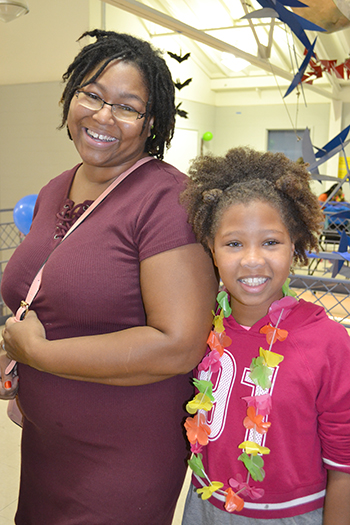
Ashanti Files and her daughter, Camille.
And that was the exact reason that Ashantie Files, mother of local 5th grader Camille, brought her daughter to the event: “I thought it would be good for her to see that this is a field she can get into,” Files admits, “a field that she'll have a lot of support in. And just kind of see what they have available.”
To make the day a bit more fun and exciting for the girls, the theme of the whole event was about Moana, a recent popular Disney movie about a young Polynesian princess. The girls participated in a total of seven activities, each of which introduced the girls to a different engineering discipline and incorporated Moana in some way or another. For example, in the civil engineering activity, the girls had to build a house out of Play-Doh, popsicle sticks, and paper. When each girl was done creating her house, it then had to withstand hurricane-like conditions like those Moana might have encountered (meaning it was blown with a hair dryer then splashed with water).
For the industrial engineering activity, girls used aluminum foil, toothpicks, and pipe cleaners to build a boat (Moana was in boats a lot), which was then tested by being placed in a bin of water and loaded down with coins, to see how much weight it could hold, thus proving how sturdy it was . Another activity they did involved “the claw,” which was a mechanical engineering activity that used hydraulics and syringes. For a bioengineering activity, the girls were taught about genetics and Punnet squares, and how engineering can be applied to genetics to improve the lives of patients with certain diseases. Each activity was run by one or more SWE students from the activity’s engineering major, if possible, who would be able to tell the girls (and their moms) more about each discipline.
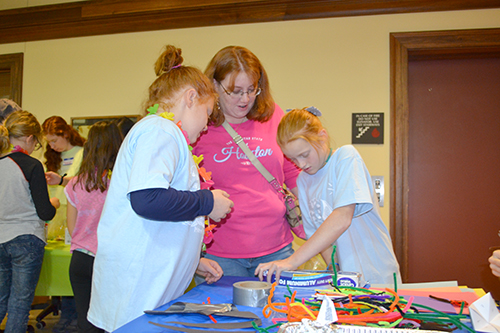
Above and Below: Sarah McCormick and her two daughters: Ella and Ali McCormick.
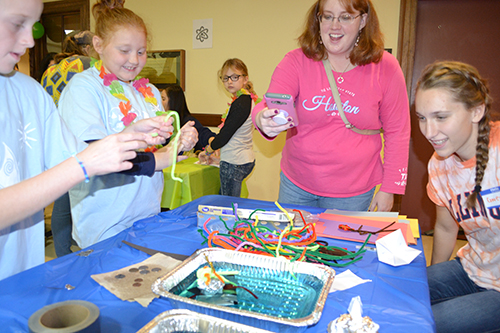
One local mother, Sarah McCormick, who actually brought both of her daughters to the event, hoped that her girls would be able to find which specific disciplines relate to their interests the most: “They like to cook; they like to code; they like to mix properties, make potions. And so I wanted to let them understand all of the different types of engineering that there are so they can look at different career options that are non-traditional for girls.”
The day even included a quiz for the girls to take that asked them questions in order to determine their personality, then matched them up with what type of engineer they should be in the future! (Lest the reader question the effectiveness of the tool, many Illinois Engineering students who participate in SWE also took the quiz, and nearly all of them were matched with the major they currently are in.)
Katherine Kiang, one of SWE’s outreach co-directors, was very excited about having girls in grades 4–6 at the event. “A unique thing with 4th–6th graders is they're kind of in a transition period right before middle school, where they might not necessarily have quite the same enthusiasm a little kid has about things that are flashy-sciency, though we want to maintain that enthusiasm that might have been sparked.” Kiang says. “Something interesting with this group,” she adds. “They do have excitement, more so than middle schoolers. But they understand more than younger kids. So that's always a really exciting age group to see how that works together.”
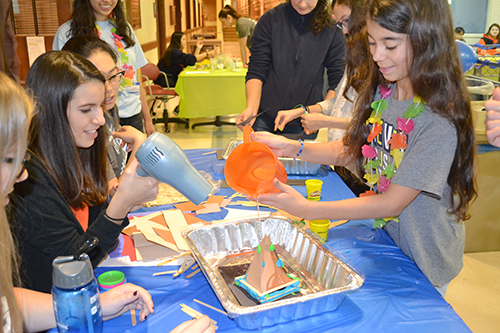
Above: Miranda Burgos tests to see if her house made out of Play-Doh, popsicle sticks, and paper can withstand hurricane-like conditions (blown with a hair dryer then splashed with water).
Below: Miranda Burgos shows off her house to her mom, Dolly.
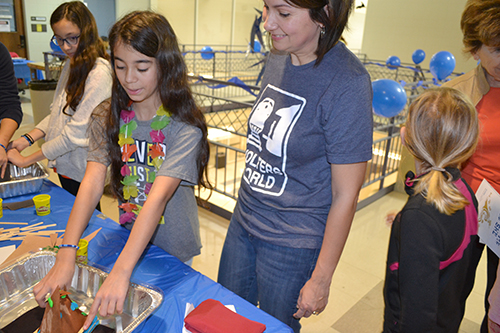
Kiang, a senior in Bioengineering, has been involved with SWE’s outreach committee since her freshman year and even almost became an education major. “I've always been passionate about teaching children and inspiring the next generation of engineers,” she acknowledges. Kiang is on a mission to create events for SWE that are self-sustaining, so she can have a lasting impact even after she graduates. SWE Next is one program she’s working on, which focuses on girls in grades K–12. It’s designed to inform girls about local STEM activities and help them create a STEM club for girls at their schools.
The other SWE outreach co-director who helped plan the event is environmental engineering major Megan Fox. Fox has been involved in SWE’s outreach committee for the past two years, and has loved every bit of it: “It's been the joy of every Saturday, and getting to see the kids learn about engineering, it kind of takes you back to when you were a kid and seeing what STEM did for you and how you got to where you are now. It definitely makes you a lot happier, and all the hard work of engineering a little more worth it.”
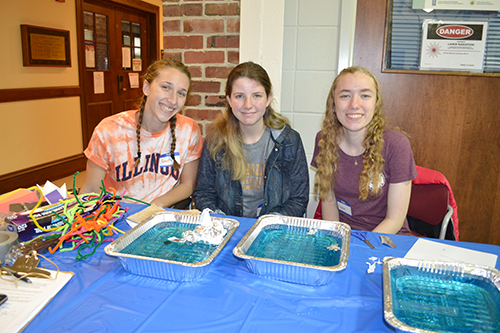
SWE members (left to right: Gwen Kramer, Sarah Lehman, Debbie Wiegand).
Other members of SWE heard about the event through the “SWEekly,” a weekly newsletter published by SWE that informs members of events in which they can participate. Gwen Kramer, a freshman in civil engineering, who is also a swim instructor, says she loves hanging out with kids. She indicates that it “looked like an awesome event,” so she decided to attend. Debbie Wiegand, a sophomore in aerospace engineering, worked at a day care throughout high school. Her experiences there actually inspired her to join the SWE outreach committee, which has allowed her to do something she loves: “working with kids and introducing them to engineering.”
The event even included students from schools other than University of Illinois. Sarah Lehman is a freshman in mechanical engineering at Olivet Nazarene University (ONU). ONU partnered with Illinois’ SWE program for the event, and sent Sarah, along with a few others, to participate. Sarah loved the experience, especially “working with the kids and seeing how creative they get.”
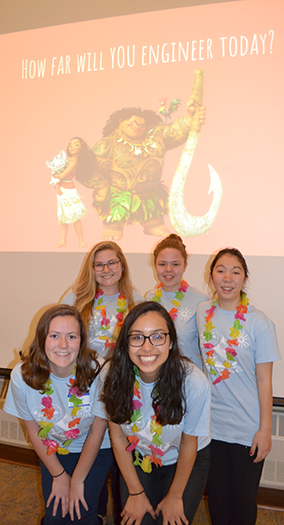
SWE Outreach Leaders (clockwise from the top left: Kylie Burkett, Courtney Duncan, Katherine Kiang, Katherine Bohorquez, Megan Fox).
Story by: Patrick Pavilonis, I-STEM Undergradute Student Worker and a junior studying Math and Science Education
Photographs by: Elizabeth Innes, Communications Specialist, I-STEM Education Initiative
More: K-6 Outreach, SWE, Women in STEM, 2017
For additional I-STEM web articles about SWE, see:
- Mommy, Me, & SWE: Middle School Girls Find Out About Engineering While Finding Dory
- During SWE’s Round Robin, Girls of All Ages Become More Well-Rounded in Engineering Disciplines
- Girls Discover that Engineering Is Sweet at Introduce-A-Girl-to-Engineering Day
- SWE's Rockin' Engineering Round Robin Tells Girls: "You Can Be An Engineer and Still Be Yourself!"
- Mommy, Me, and SWE Strives to Convince Girls That They Can Be Engineers Too
- Introduce-a-Girl-to-Engineering Day Tells Girls: "You Can Be an Engineer, Change the World!”
- SWE Outreach Seeks to Interest Kids in Engineering and Say, “You Can Do It Too!”

A local mother and and her daughters enjoy Mommy, Me, and SWE.













.jpg)
















